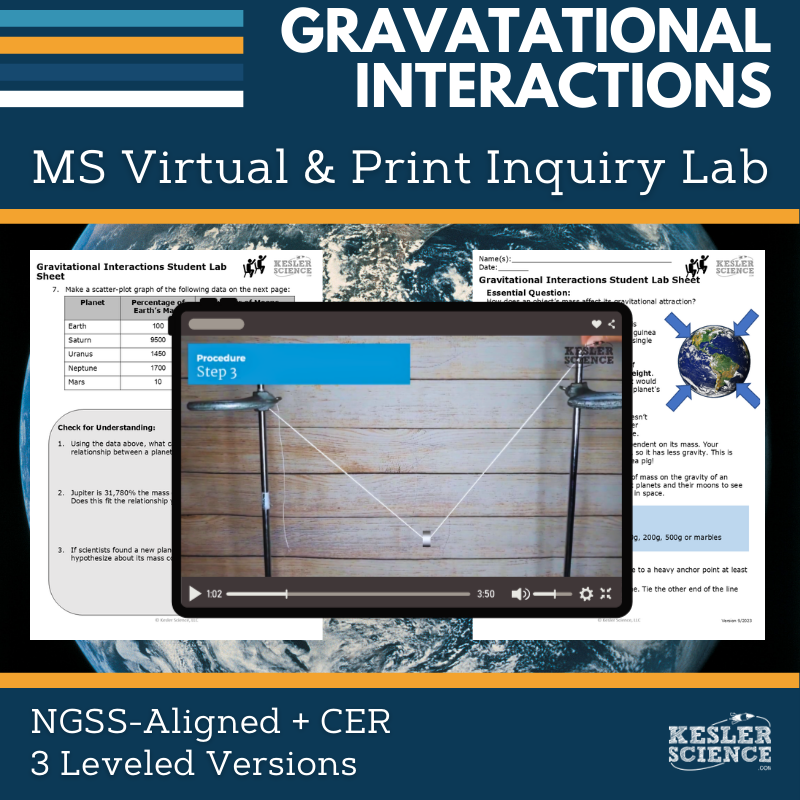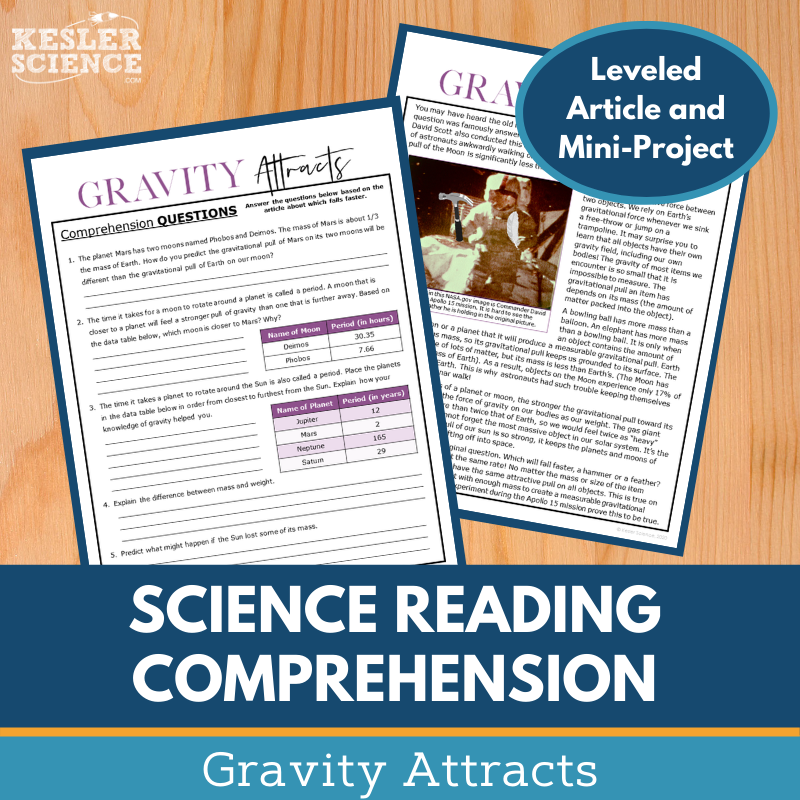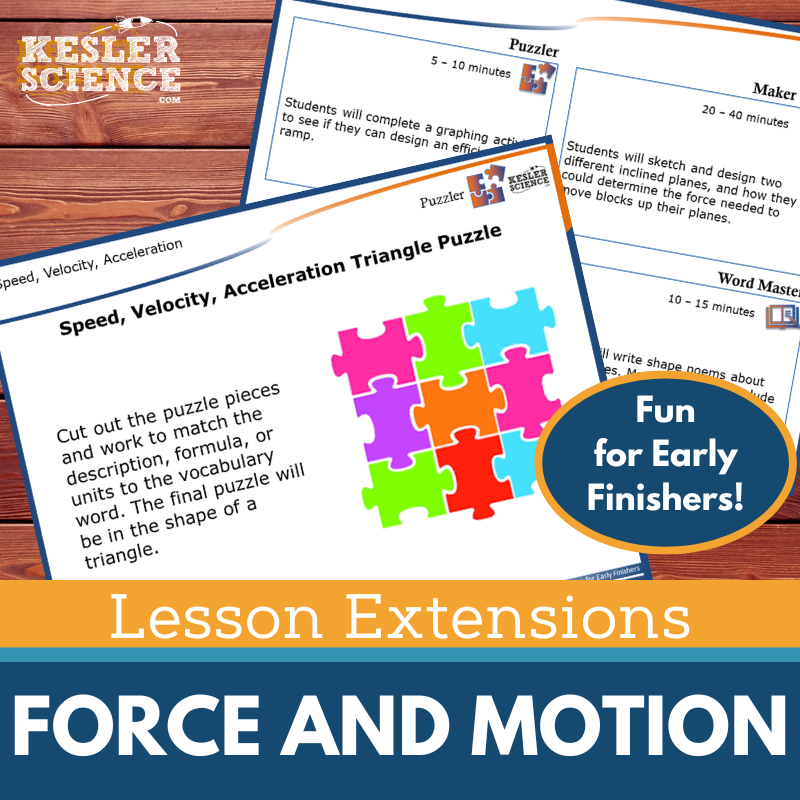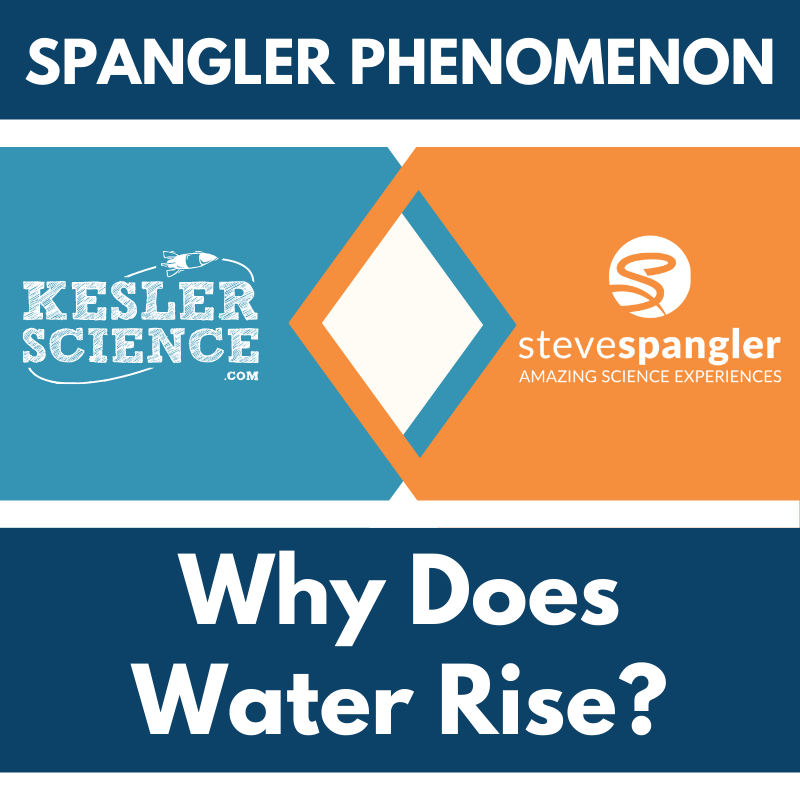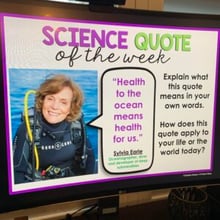Gravitational Interactions Activities for Middle School Science
Students explore the relationship between mass and gravitational interactions through engaging, hands-on, and digital activities aligned with NGSS MS-PS2-4. The resources below will give students a comprehensive understanding of gravitational interactions. All of the following materials are also included in the Kesler Science Membership.
The Gravitational Interactions Inquiry Lab aligns with NGSS MS-PS2-4, guiding students to explore how an object's mass affects its gravitational attraction. This lab includes both a hands-on printed experiment and a virtual demonstration with a pre-recorded video. Students engage with comprehension questions, Claim-Evidence-Reasoning (C.E.R.) prompts, and a reflection section.
The lab models the effects of mass on gravity by having students examine planets and their moons, then analyze the relationship between mass and gravitational interactions. Differentiation is built-in with three levels: Dependent (guided inquiry), Modified (structured with supports), and Independent (student-led exploration).
The print version provides a hands-on experience where students use fishing line, washers, and various weights to model gravitational interactions. Each student completes their own sheet, even if working in groups. The digital version is an interactive PowerPoint compatible with Google Slides, MS Teams, Schoology, and Canvas, featuring embedded virtual activities and a recorded procedure video for accessibility.
Kesler Science ensures flexibility with editable PowerPoints, multimodal learning, and teacher resource pages, including answer keys, standards, objectives, and additional materials. The lab is available in both digital and print formats with differentiated versions for diverse learners.
The Gravitational Interactions Inquiry Lab aligns with NGSS MS-PS2-4, guiding students to explore how an object's mass affects its gravitational attraction. This lab includes both a hands-on printed experiment and a virtual demonstration with a pre-recorded video. Students engage with comprehension questions, Claim-Evidence-Reasoning (C.E.R.) prompts, and a reflection section.
The lab models the effects of mass on gravity by having students examine planets and their moons, then analyze the relationship between mass and gravitational interactions. Differentiation is built-in with three levels: Dependent (guided inquiry), Modified (structured with supports), and Independent (student-led exploration).
The print version provides a hands-on experience where students use fishing line, washers, and various weights to model gravitational interactions. Each student completes their own sheet, even if working in groups. The digital version is an interactive PowerPoint compatible with Google Slides, MS Teams, Schoology, and Canvas, featuring embedded virtual activities and a recorded procedure video for accessibility.
Kesler Science ensures flexibility with editable PowerPoints, multimodal learning, and teacher resource pages, including answer keys, standards, objectives, and additional materials. The lab is available in both digital and print formats with differentiated versions for diverse learners.
This Gravity Attracts Science Reading Comprehension Lesson helps students explore how gravitational interactions depend on the masses of objects. Designed for middle school, the leveled passage supports science literacy and reading comprehension.
The resource includes a nonfiction article, five to seven comprehension questions, and a hands-on mini-project where students test if Earth's gravitational pull is the same for all objects. A Cornell notes template is also provided.
Perfect for sub plans, ISS, extra credit, or whole-class instruction, this resource fosters critical thinking, classroom discussions, and textual analysis. It is compatible with both in-person and virtual learning platforms like Google Classroom, MS Teams, Schoology, and Canvas.
This Gravity Attracts Science Reading Comprehension Lesson helps students explore how gravitational interactions depend on the masses of objects. Designed for middle school, the leveled passage supports science literacy and reading comprehension.
The resource includes a nonfiction article, five to seven comprehension questions, and a hands-on mini-project where students test if Earth's gravitational pull is the same for all objects. A Cornell notes template is also provided.
Perfect for sub plans, ISS, extra credit, or whole-class instruction, this resource fosters critical thinking, classroom discussions, and textual analysis. It is compatible with both in-person and virtual learning platforms like Google Classroom, MS Teams, Schoology, and Canvas.
The Gravitational Interactions Science Writing Prompt Activity engages middle school students in a creative interview-style writing exercise to reinforce their understanding of gravitational interactions. Aligned with NGSS MS-PS2-4, this activity helps students construct and present arguments using evidence to support the claim that gravitational interactions are attractive and depend on the masses of interacting objects. Designed for both in-person and virtual learning, it promotes science reasoning and exploration through engaging writing.
This resource includes teacher directions with an answer guide, project ideas, and rubrics, as well as projection and print handouts in full-sized and half-sheet formats. A digital interactive PowerPoint version, compatible with Google Slides, allows for flexible use in various learning environments. Ideal for cross-curricular activities, pre-test assessments, student choice projects, early finisher tasks, extra credit, make-up work, and differentiation, this writing prompt fosters creativity and science literacy. It can also be displayed on bulletin boards or compiled into student anthologies, making it a valuable addition to any science classroom.
The Gravitational Interactions Science Writing Prompt Activity engages middle school students in a creative interview-style writing exercise to reinforce their understanding of gravitational interactions. Aligned with NGSS MS-PS2-4, this activity helps students construct and present arguments using evidence to support the claim that gravitational interactions are attractive and depend on the masses of interacting objects. Designed for both in-person and virtual learning, it promotes science reasoning and exploration through engaging writing.
This resource includes teacher directions with an answer guide, project ideas, and rubrics, as well as projection and print handouts in full-sized and half-sheet formats. A digital interactive PowerPoint version, compatible with Google Slides, allows for flexible use in various learning environments. Ideal for cross-curricular activities, pre-test assessments, student choice projects, early finisher tasks, extra credit, make-up work, and differentiation, this writing prompt fosters creativity and science literacy. It can also be displayed on bulletin boards or compiled into student anthologies, making it a valuable addition to any science classroom.
The WIKI Tickets© Force and Motion Set provides engaging, flexible formative assessments for 6th-8th grade science. This set includes 14 topics, each with five format options: a full-screen projection version, three print handouts, and an interactive digital version compatible with PowerPoint and Google Slides.
Aligned with NGSS and TEKS standards, these assessments cover key concepts such as calculating speed and unbalanced forces, graphing motion, Newton’s laws, gravity and mass, inclined planes, invisible forces, and velocity and acceleration. A table of contents file is included to show alignment with standards.
Designed for both in-person and virtual learning, WIKI Tickets© can be used as exit tickets, bellringers, or quick checks. Students can write responses on paper, complete printed versions, or interact with the digital files in a 1:1 or remote setting. These colorful, engaging assessments help you gauge student understanding with ease.
The WIKI Tickets© Force and Motion Set provides engaging, flexible formative assessments for 6th-8th grade science. This set includes 14 topics, each with five format options: a full-screen projection version, three print handouts, and an interactive digital version compatible with PowerPoint and Google Slides.
Aligned with NGSS and TEKS standards, these assessments cover key concepts such as calculating speed and unbalanced forces, graphing motion, Newton’s laws, gravity and mass, inclined planes, invisible forces, and velocity and acceleration. A table of contents file is included to show alignment with standards.
Designed for both in-person and virtual learning, WIKI Tickets© can be used as exit tickets, bellringers, or quick checks. Students can write responses on paper, complete printed versions, or interact with the digital files in a 1:1 or remote setting. These colorful, engaging assessments help you gauge student understanding with ease.
Lesson Extensions provide engaging, student-choice activities designed to challenge early finishers and deepen their understanding of force and motion standards. These activities help reinforce critical thinking, fill downtime, and keep students engaged with rigorous yet enjoyable learning opportunities. Aligned to NGSS and TEKS, they offer high-level enrichment that encourages deeper exploration of key physics concepts.
Each extension includes four interactive components: Puzzler for problem-solving, Maker Space for hands-on STEAM activities, Tech Connection for digital demonstrations, and Word Master for creative writing. With teacher directions, answer keys, and both print and projection versions, these extensions are perfect for lesson wrap-ups, enrichment, or independent challenges.
Covering topics such as Newton’s laws, motion and forces, gravity, speed, velocity, acceleration, and electromagnetic forces, these extensions ensure students remain engaged while strengthening their understanding of fundamental physics concepts.
Lesson Extensions provide engaging, student-choice activities designed to challenge early finishers and deepen their understanding of force and motion standards. These activities help reinforce critical thinking, fill downtime, and keep students engaged with rigorous yet enjoyable learning opportunities. Aligned to NGSS and TEKS, they offer high-level enrichment that encourages deeper exploration of key physics concepts.
Each extension includes four interactive components: Puzzler for problem-solving, Maker Space for hands-on STEAM activities, Tech Connection for digital demonstrations, and Word Master for creative writing. With teacher directions, answer keys, and both print and projection versions, these extensions are perfect for lesson wrap-ups, enrichment, or independent challenges.
Covering topics such as Newton’s laws, motion and forces, gravity, speed, velocity, acceleration, and electromagnetic forces, these extensions ensure students remain engaged while strengthening their understanding of fundamental physics concepts.
This Amazing Anchors Phenomenon Lesson introduces gravitational interactions through real-world connections. It includes an introductory reading focused on astronauts in space, with comprehension and extension questions to prepare students for further learning. An explanatory reading simplifies the science behind gravitational interactions, reinforcing understanding with additional questions.
Aligned with NGSS standard MS PS2-4, this no-prep resource includes teacher directions, answer keys, projection slides, and both print and digital formats for Google Classroom and other LMS platforms. A differentiated version supports student learning with modified language and sentence starters. Designed to bookend a lesson, these engaging readings enhance the Engagement and Elaborate segments of 5E lessons, making them a valuable supplement to any in-person or virtual classroom.
This Amazing Anchors Phenomenon Lesson introduces gravitational interactions through real-world connections. It includes an introductory reading focused on astronauts in space, with comprehension and extension questions to prepare students for further learning. An explanatory reading simplifies the science behind gravitational interactions, reinforcing understanding with additional questions.
Aligned with NGSS standard MS PS2-4, this no-prep resource includes teacher directions, answer keys, projection slides, and both print and digital formats for Google Classroom and other LMS platforms. A differentiated version supports student learning with modified language and sentence starters. Designed to bookend a lesson, these engaging readings enhance the Engagement and Elaborate segments of 5E lessons, making them a valuable supplement to any in-person or virtual classroom.
This Spangler Phenomenon lesson on mass and gravitational interactions features an exclusive Steve Spangler video and an engaging investigation that challenges students to answer the question: If you had to prove something was affected by gravity, what evidence would you need?
Aligned to the 5E framework and NGSS physical science standards, this lesson explores the concept of gravitational interactions being attractive and dependent on mass. Students engage with the crosscutting concept of structure and function and practice obtaining, evaluating, and communicating information.
In Part 1, students think like scientists as they observe a phenomenon related to mass and gravity, watch the Why Does Water Rise? video, and conduct their own water-rising demonstration. In Part 2, they study like scientists by gathering information from an article and expanding their understanding through optional activities like Station Labs and Inquiry Labs. In Part 3, students work like scientists by reevaluating their conclusions after watching an explanation video. They then demonstrate their understanding through writing, drawing, or building activities.
The lesson includes teacher directions with a materials list, learning objectives, and answer keys, along with student handouts, two Steve Spangler videos, and clear presentation slides in both standard and digital interactive formats. PowerPoint files can be seamlessly uploaded to Google Slides, and Vimeo links ensure an ad-free viewing experience.
This Spangler Phenomenon lesson on mass and gravitational interactions features an exclusive Steve Spangler video and an engaging investigation that challenges students to answer the question: If you had to prove something was affected by gravity, what evidence would you need?
Aligned to the 5E framework and NGSS physical science standards, this lesson explores the concept of gravitational interactions being attractive and dependent on mass. Students engage with the crosscutting concept of structure and function and practice obtaining, evaluating, and communicating information.
In Part 1, students think like scientists as they observe a phenomenon related to mass and gravity, watch the Why Does Water Rise? video, and conduct their own water-rising demonstration. In Part 2, they study like scientists by gathering information from an article and expanding their understanding through optional activities like Station Labs and Inquiry Labs. In Part 3, students work like scientists by reevaluating their conclusions after watching an explanation video. They then demonstrate their understanding through writing, drawing, or building activities.
The lesson includes teacher directions with a materials list, learning objectives, and answer keys, along with student handouts, two Steve Spangler videos, and clear presentation slides in both standard and digital interactive formats. PowerPoint files can be seamlessly uploaded to Google Slides, and Vimeo links ensure an ad-free viewing experience.
Year-Round Resources
These year-round activities will increase your students' understanding of many middle school science topics. All of these activities are also included in the Kesler Science Membership.
Visual Data & Graphing
You're not alone if your students struggle with understanding graphs, charts, and tables. It's a skill that takes an enormous amount of practice. This resource will help students build a strong foundation in analyzing data and creating their own data visualizations.
Bell Ringers and Warm-Ups
These middle school science bell ringers are an excellent way to engage your students as soon as they walk into your classroom. This comprehensive FULL YEAR resource includes everything you need to start off each science class with an interesting warm-up activity.
Review Board Games
Each game board has been carefully designed to keep students engaged. There are 10 different action spaces on each board and dozens of question cards. All of the actions are related to science concepts and keep the students motivated throughout the game.
Each game is ready to play. Simply print out the board and the cards and let the students enjoy reviewing nine different units.
Essential Questions and Standards
Below are the essential questions and standards associated with the lessons and activities included in the gravitational interactions unit. This topic is only one of more than 100 middle school science topics included in the Kesler Science Membership.
-
How does an object’s mass affect its gravitational attraction?
-
NGSS - MS-PS2-4 Gravitational Interactions
Kesler Science Membership
Imagine never having to search for another middle school science lesson again. The membership gives you access to ALL of the Kesler Science products in one place (Yes, including everything above).
Say goodbye to long hours of lesson prep.

